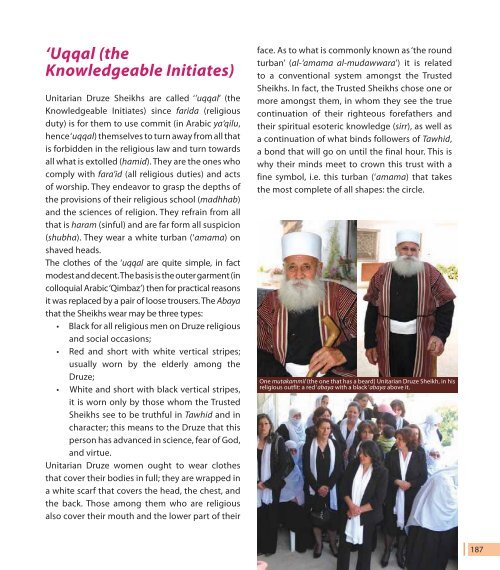Cultural aspects in Christian and Islamic religions - unesdoc - Unesco
Cultural aspects in Christian and Islamic religions - unesdoc - Unesco
Cultural aspects in Christian and Islamic religions - unesdoc - Unesco
Create successful ePaper yourself
Turn your PDF publications into a flip-book with our unique Google optimized e-Paper software.
‘Uqqal (the<br />
Knowledgeable Initiates)<br />
Unitarian Druze Sheikhs are called ‘’uqqal’ (the<br />
Knowledgeable Initiates) s<strong>in</strong>ce farida (religious<br />
duty) is for them to use commit (<strong>in</strong> Arabic ya‘qilu,<br />
hence ‘uqqal) themselves to turn away from all that<br />
is forbidden <strong>in</strong> the religious law <strong>and</strong> turn towards<br />
all what is extolled (hamid). They are the ones who<br />
comply with fara’id (all religious duties) <strong>and</strong> acts<br />
of worship. They endeavor to grasp the depths of<br />
the provisions of their religious school (madhhab)<br />
<strong>and</strong> the sciences of religion. They refra<strong>in</strong> from all<br />
that is haram (s<strong>in</strong>ful) <strong>and</strong> are far form all suspicion<br />
(shubha). They wear a white turban (‘amama) on<br />
shaved heads.<br />
The clothes of the ‘uqqal are quite simple, <strong>in</strong> fact<br />
modest <strong>and</strong> decent. The basis is the outer garment (<strong>in</strong><br />
colloquial Arabic ‘Qimbaz’) then for practical reasons<br />
it was replaced by a pair of loose trousers. The Abaya<br />
that the Sheikhs wear may be three types:<br />
<br />
<strong>and</strong> social occasions;<br />
<br />
usually worn by the elderly among the<br />
Druze;<br />
<br />
it is worn only by those whom the Trusted<br />
Sheikhs see to be truthful <strong>in</strong> Tawhid <strong>and</strong> <strong>in</strong><br />
character; this means to the Druze that this<br />
person has advanced <strong>in</strong> science, fear of God,<br />
<strong>and</strong> virtue.<br />
Unitarian Druze women ought to wear clothes<br />
that cover their bodies <strong>in</strong> full; they are wrapped <strong>in</strong><br />
a white scarf that covers the head, the chest, <strong>and</strong><br />
the back. Those among them who are religious<br />
also cover their mouth <strong>and</strong> the lower part of their<br />
face. As to what is commonly known as ‘the round<br />
turban’ (al-‘amama al-mudawwara’) it is related<br />
to a conventional system amongst the Trusted<br />
Sheikhs. In fact, the Trusted Sheikhs chose one or<br />
more amongst them, <strong>in</strong> whom they see the true<br />
cont<strong>in</strong>uation of their righteous forefathers <strong>and</strong><br />
their spiritual esoteric knowledge (sirr), as well as<br />
a cont<strong>in</strong>uation of what b<strong>in</strong>ds followers of Tawhid,<br />
a bond that will go on until the f<strong>in</strong>al hour. This is<br />
why their m<strong>in</strong>ds meet to crown this trust with a<br />
f<strong>in</strong>e symbol, i.e. this turban (‘amama) that takes<br />
the most complete of all shapes: the circle.<br />
One mutakammil (the one that has a beard) Unitarian Druze Sheikh, <strong>in</strong> his<br />
religious outfit: a red ‘abaya with a black ‘abaya above it.<br />
187

















